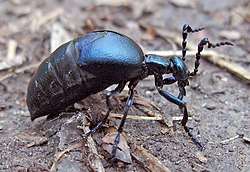Meloe
The blister beetle genus Meloe is a large, widespread group commonly referred to as oil beetles.[1] They are known as "oil beetles" because they release oily droplets of hemolymph from their joints when disturbed; this contains cantharidin, a poisonous chemical causing blistering of the skin and painful swelling. Members of this genus are typically flightless, without functional wings, and shortened elytra.
| Meloe | |
|---|---|
 | |
| Meloe violaceus | |
| Scientific classification | |
| Kingdom: | |
| Phylum: | |
| Class: | |
| Order: | |
| Family: | |
| Subfamily: | |
| Genus: | Meloe |
| Species | |
|
See text | |
As in other members of the family, they are hypermetamorphic, going through several larval stages, the first of which is typically a mobile triungulin that finds and attaches to a host in order to gain access to the host's offspring. In this genus, the host is a bee, and each species of Meloe may attack only a single species or genus of bees; while sometimes considered parasitoids, it appears that in general, the Meloe larva consumes the bee larva along with its provisions, and can often survive on the provisions alone, thus they do not truly qualified (see Parasitoid for definition).
Species
Arranged alphabetically.[2][3]
- Meloe afer Bland, 1864
- Meloe ajax Pinto, 1998
- Meloe aleuticus Borchmann, 1942
- Meloe americanus Leach, 1815
- Meloe angusticollis Say, 1824 – Short-winged Blister Beetle
- Meloe barbarus LeConte, 1861
- Meloe bitoricollis Pinto and Selander, 1970
- Meloe brevicollis Panzer, 1793 – Short-necked Oil Beetle
- Meloe californicus Van Dyke, 1928
- Meloe campanicollis Pinto and Selander, 1970
- Meloe carbonaceus LeConte, 1866
- Meloe dianella Pinto and Selander, 1970
- Meloe dugesi Champion, 1891
- Meloe exiguus Pinto and Selander, 1970
- Meloe franciscanus Van Dyke, 1928
- Meloe gracilicornis Champion, 1891
- Meloe impressus Kirby, 1837
- Meloe laevis Leach, 1815 – Oil Beetle
- Meloe nebulosus Champion, 1891
- Meloe niger Kirby, 1837
- Meloe occultus Pinto and Selander, 1970
- Meloe paropacus Dillon, 1952
- Meloe proscarabaeus Linnaeus, 1758 - Black Oil Beetle
- Meloe quadricollis Van Dyke, 1928
- Meloe rugosus Marsham, 1802 - Rugged Oil Beetle
- Meloe strigulosus Mannerheim, 1852
- Meloe tropicus Motschulsky, 1856
- Meloe quadricollis Van Dyke, 1928
- Meloe vandykei Pinto and Selander, 1970
- Meloe variegatus Donovan, 1793
- Meloe violaceus Marsham, 1802
References
- Oil Beetles (Meloe), BugGuide
- Meloe, funet.fi
- Meloe, ITIS Report